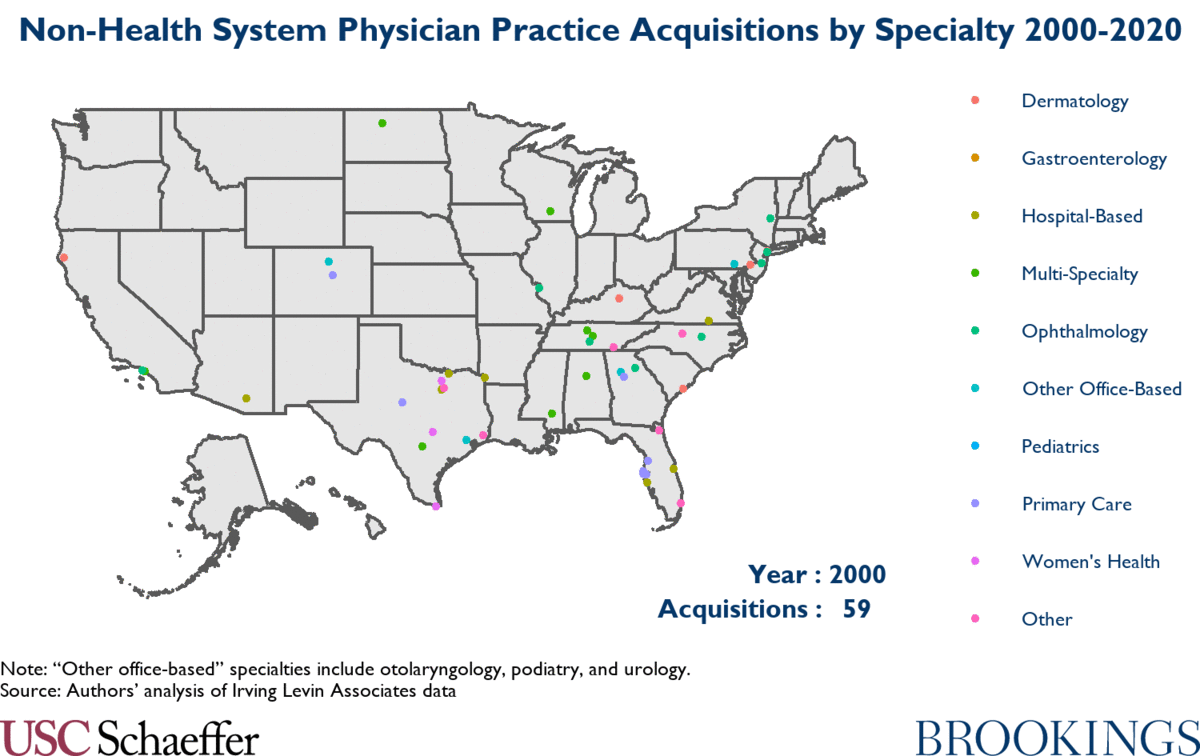

Editor’s Note: This white paper is part of the USC-Brookings Schaeffer Initiative for Health Policy, which is a partnership between the Economic Studies Program at Brookings and the USC Schaeffer Center for Health Policy & Economics. The Initiative aims to inform the national health care debate with rigorous, evidence-based analysis leading to practical recommendations using the collaborative strengths of USC and Brookings. This work was supported by Arnold Ventures.
Executive Summary
Institutional private investment in health care, particularly in physician practices and staffing companies, has increased markedly in recent years, raising concerns that an influx of profit-driven entities into the sector might raise the cost or reduce the quality of patient care. Exemplifying these concerns, private equity-backed physician staffing companies and air ambulance operators helped drive the problem of out-of-network surprise medical billing, leading to increases in both in-network and out-of-network payments and exposing consumers to unexpected financial burdens.[1],[2],[3] Private equity investor groups subsequently poured millions of dollars into lobbying to block passage of a federal surprise medical billing law until Congress passed the No Surprises Act in late 2020.[4],[5]
Nevertheless, it is unclear whether private equity investment is itself a problem or whether, in the absence of private equity, other sources of capital—such as public equity, venture capital, health systems, and insurers—would similarly exploit existing market failures and legal loopholes in the health care system. For instance, Envision and TeamHealth—the two staffing companies commonly associated with surprise out-of-network billing—were both publicly traded companies for roughly half of the 2010s, and substantial empirical evidence suggests that health system acquisition of physician practices can speed consolidation and increase costs.[6],[7] The entry of private equity into the health care sector also may provide benefits, such as increasing the availability of capital (some of which may go toward investments to improve patient care), generating economies of scale and scope, or providing a means for physicians to cash out the value of their practice or offload business and administrative responsibilities. Policies should therefore balance these benefits with countervailing harms to consumers. There are also practical limits to policymakers’ ability to target private equity investment without also ensnaring other forms of private health care transactions. Finally, the net effect of private equity investment on consumer welfare may vary across different health care sectors, geographic markets, and physician specialties.

Given a recent surge in acquisitions and the relatively nascent evidence base, it will take time to understand the impact of private equity investment on physician practices. Despite this uncertainty, this analysis identifies plausible ways that private equity’s growing health care involvement may harm consumers and physicians relative to a counterfactual without private equity investment in the health care sector:
- Private equity may more aggressively exploit market failures and payment loopholes than other potential acquirers, which could result in higher health care spending and patient and taxpayer costs.
- Private equity’s growing investment in physician practices may be accelerating horizontal consolidation in certain specialties, which a large body of evidence suggests increases prices and/or reduces the quality of care on net.
- Driven by tax and regulatory advantages, private equity might distort the organizational form of physician practices away from physician ownership. This plausibly could harm patient care and employed physicians (e.g., if anecdotal reports that private equity relies more heavily on employee noncompete and nondisclosure agreements are indicative of broader trends).
Importantly, similar critiques could be levied against growing health system or insurer ownership of physician practices. Regardless of whether private equity investment in physician practices is a problem distinct from broader health industry trends, private equity entry into a physician specialty market may signal legal loopholes and market dysfunctions ripe for policy intervention. Policy responses can target this market consolidation or exploitation of market dysfunction no matter by whom, although the entry of private equity may increase the urgency for policy changes if it indeed drives consolidation or exploits payment loopholes more quickly and extensively than would otherwise occur. But in some instances, policies targeted specifically to private equity investors may be warranted, especially if tax treatment encourages private equity ownership over other forms of ownership.
Our policy recommendations, therefore, fall into two categories: (1) policies aimed at underlying market dysfunctions not limited to private equity and (2) policies directed at private equity. The first three recommendations below fall in the first category, targeting the profit opportunities, consolidation, and dubious billing practices that private equity and other acquirers may exploit. The fourth recommendation suggests further exploration of transparency, tax reforms, and corporate practice of medicine standards specifically targeted at private equity.
Recommendation 1: Close payment loopholes that raise costs for consumers and taxpayers. Myriad payment policies create perverse incentives to deliver care, bill, or code patients in a specific way to increase revenues without commensurate patient benefits. Along with out-of-network surprise billing, other payment policies that create perverse incentives include Medicare Part B payment policy for physician-administered drugs and insurers’ ability to aggressively code enrollee diagnosis codes to increase Medicare Advantage payments.
Recommendation 2: Enhance enforcement under antitrust and employment laws to address consolidation and anticompetitive contracting practices imposed on acquired physicians. To increase antitrust scrutiny of physician acquisitions that currently escape review, the Hart-Scott-Rodino Act reporting threshold should be reduced or eliminated for health care transactions, enabling pre-merger review of physician practice acquisitions and add-on acquisitions. States can also require pre-merger review of major transactions involving physician practices and regulate noncompete, nondisclosure, and non-disparagement agreements for employed physicians of acquired practices.
Recommendation 3: Increase fraud and abuse enforcement to penalize physician practices engaging in questionable billing and referral strategies and enable government payers to recoup ill-gotten profits. The pressure to rapidly increase the profitability of acquired practices raises risks of overutilization, overbilling or upcoding, medically unnecessary care, and self-referrals for ancillary services. Stepped-up scrutiny and enforcement under existing federal fraud and abuse laws (including the False Claims Act, Anti-Kickback Statute, Stark Law, and state law counterparts) by government and private whistleblowers against investors and acquired physician practices could curb fraud and abuse risks. In addition, tightening rules around self-referral for ancillary services under these laws may be needed to counter overutilization.
Recommendation 4: Explore policies targeting private equity. To the extent private equity raises different or greater risks than other sources of capital in the health care sector, policies specific to private equity may help level the playing field for all types of investment. These include policies to increase transparency of private equity ownership of physician practices to policymakers and regulators; changes to federal tax policy to treat the private equity firm’s share of income from owned practices (arguably better thought of as payment for investment management services) as ordinary income rather than long-term capital gains; and exploration of extending state-level corporate practice of medicine laws, ethical guidelines, and professional licensing standards to address the revenue pressures and corporate controls that private equity investors may exert over acquired physician practices.
Footnotes:
[1] Cooper, Zack, Fiona Scott Morton, and Nathan Shekita. “Surprise! Out-of-Network Billing for Emergency Care in the United States.” Journal of Political Economy 128, no. 9 (2020): 3626-77, https://doi.org/10.1086/708819.
[2] Adler, Loren, Kathleen Hannick, and Sobin Lee, “High Air Ambulance Charges Concentrated in Private Equity-Owned Carriers,” Brookings, October 13, 2020, https://healthpolicy.usc.edu/brookings-schaeffer/high-air-ambulance-charges-concentrated-in-private-equity-owned-carriers/.
[3] Duffy, Erin L., Bich Ly, Loren Adler, and Erin Trish. “Policies to Address Surprise Billing Can Affect Health Insurance Premiums.” The American Journal of Managed Care 26, no. 9 (2020): 401-4, https://doi.org/10.37765/ajmc.2020.88491.
[4] Fuse Brown, Erin C.. “Stalled Federal Efforts to End Surprise Billing—The Role of Private Equity.” New England Journal of Medicine 382, no. 13 (2020): 1189-91, https://doi.org/10.1056/NEJMp1916443.
[5] No Surprises Act, H.R. 3630, 116th Cong. (2019-2020).
[6] O’Hanlon, Claire E., Christopher M. Whaley, and Deborah Freund. “Medical Practice Consolidation and Physician Shared Patient Network Size, Strength, And Stability.” Medical Care 57, no. 9 (2019): 680-687, https://doi.org/10.1097/MLR.0000000000001168.
[7] Christianson, Jon B., Caroline S. Carlin, and Louise H. Warrick. “The Dynamics of Community Health Care Consolidation: Acquisition of Physician Practices.” Milbank Quarterly 92, no. 3 (2014): 542-567, https://doi.org/10.1111/1468-0009.12077.
Disclosures:
This work was supported by Arnold Ventures. The funder had no involvement in the collection,
analysis and interpretation of data; in the writing of the analysis; or in the decision to publish. Erin
Fuse Brown is a consultant to the National Academy for State Health Policy and an Advisory Board
member for Catalyst for Payment Reform. Paul Ginsburg is a Public Trustee of the American Academy
of Ophthalmology and an Advisory Board member of the National Institute for Health Care
Management. Other than the aforementioned, the authors did not receive financial support from any
firm or person for this paper and they are currently not an officer, director, or board member of any
organization with an interest in this paper.
The Brookings Institution is financed through the support of a diverse array of foundations,
corporations, governments, individuals, as well as an endowment. A list of donors can be found in
our annual reports published online here. The findings, interpretations, and conclusions in this report
are solely those of its author(s) and are not influenced by any donation.
Acknowledgments: The authors thank Erin Trish for her intellectual contributions and Laura Alexander, David Demres, Matthew Fiedler, Bob Kocher, Richard Scheffler, and Misha Segal for helpful comments on a draft of this paper. We thank Joseph Allen, Kathleen Hannick, Mengqi Rebecca Hsu, Alex McDonald, Conrad Milhaupt, and Jake Summerlin for their research assistance and Alwyn Cassil for her editorial contributions.





